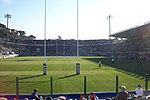Accademia Nazionale di Santa Cecilia Musical Instruments Museum
2008 establishments in ItalyArchitecture stubsCommons link is the pagenameMuseums established in 2008Museums in Rome ... and 4 more
Music museums in ItalyMusical instrument museums in ItalyRenzo Piano buildingsRome Q. II Parioli

The Accademia Nazionale di Santa Cecilia Musical Instruments Museum (MUSA) is the museum holding the instruments collection of musical instruments of the Accademia Nazionale di Santa Cecilia.
Excerpt from the Wikipedia article Accademia Nazionale di Santa Cecilia Musical Instruments Museum (License: CC BY-SA 3.0, Authors, Images).Accademia Nazionale di Santa Cecilia Musical Instruments Museum
Viale Pietro de Coubertin, Rome Parioli
Geographical coordinates (GPS) Address Website Nearby Places Show on map
Geographical coordinates (GPS)
| Latitude | Longitude |
|---|---|
| N 41.928931 ° | E 12.474794 ° |
Address
Auditorium Parco della Musica (Parco della Musica)
Viale Pietro de Coubertin 30
00196 Rome, Parioli
Lazio, Italy
Open on Google Maps









